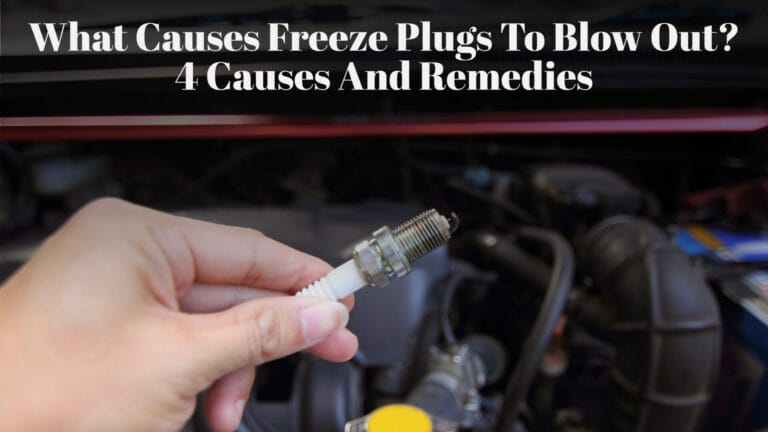Can A Car Roll Backwards In 1st Gear? How to Prevent It?
Driving a car on a steep road or on a hill is a challenging task. It is tricky to start the car in the perfect manner to prevent a car roll backwards in 1st gear. You may get confused about whether to start your car by shifting to 1st gear, in the park, or neutral.
But can a car roll backward in 1st year?
The short answer is yes, it can if you are on a steep highway or slope hills. It happens as the engine’s compression alone is not powerful enough to counteract the force of gravity on your car. Try engaging the handbrake before releasing the footbrake. Using the clutch and brake together can also help.
Let’s explore why the car rolls back and how you can prevent it and experience a safe drive.
Can a Car Roll Backward in 1st Gear? Why Does It Happen?
As we mentioned before, your car can roll backward in 1st gear. It happens on a slope because of the force of gravity overcoming the engine’s resistance.

The engine of your car provides low-speed power in 1st gear. The compression alone cannot generate enough power to overcome the gravitational force without gas input.
To prevent rolling, your car needs to generate enough power to withstand its mass and the power of gravity. The first gear can only produce enough torque to get the car moving. You have to take other precautions to prevent your car from rolling.
How to Prevent Rolling Backward in 1st Gear With a Manual Transmission?
You need to follow different approaches to prevent rolling in manual and automatic transmission. If you drive a manual transmission car, follow these steps.
Step 1: Use Hill-Start Mode
Before shifting into first gear, switch on the “hill-start assistance.” This function may not be available to all cars. Check if you have this, as it can be quite helpful in such conditions. This ensures that your car is not going to roll backward when you are on a slope. This function automatically detects if your car is on an incline.
When activated, the sensor temporarily holds the brake pressure for a short period when you press the brake pedal. It gives better brake control and smooth transition. The system gets deactivated after a few seconds or as soon as you apply the accelerator.
Step 2: Lift the Clutch
Once you have shifted into the first gear, lift the clutch. Make sure the clutch plate and the flywheel make initial contact to allow the transmission of power from the engine to the gearbox.
Step 3: Use the Handbrake or Brake Pedal
Do not release the foot brake without engaging the handbrake to keep the vehicle stationary. Using the handbrake provides you additional security. Release the handbrake gradually and keep pressing the acceleration at the same time. Your car will slowly move upward without losing its grip on the road.
It is okay if your car does not have a handbrake or if you do not want to use it. You can hold the foot brake while listing the clutch and applying the accelerator. This might be a little complicated, but it is still as safe as using a handbrake.
Step 4: Release the Clutch
When you are releasing the handbrake, continue lifting the clutch to fully engage the transmission. Be patient and do it smoothly to prevent sudden jolts or stalls.
You can watch this video for more help:
How to Prevent Rolling With an Automatic Transmission

Starting your car on a slope with an automatic transmission is comparatively easy. However, you still need to be careful and perform the following steps to ensure safety.
Step 1: Use the Foot Brake
If your car is parked on a slope or inclined surface, you have to keep your foot firmly pressed on the brake pedal. It ensures that the vehicle does not move or roll backward.
Step 2: Shift into Drive
Shift the gear lever into the “Drive” position before releasing the brake. This will prepare the transmission to generate power and deliver it to the wheels when you accelerate.
Step 3: Engage the Parking or Handbrake
This is not a mandatory option, but it increases your safety level. Engaging the electronic brake is an ideal practice for automatic transmissions. It secures your car from rolling by providing an extra layer of safety. However, you can still move up safely without using the handbrake.
Step 4: Release the Brake Gradually
Start releasing the brake gradually. Do not keep your foot off the brake completely yet. You have to be careful to do it with ease and smoothness to avoid sudden jerks. Your car will remain stationary as long as you have kept the pedal pressed.
Step 5: Slowly Press the Accelerate.
After releasing the brake, begin to apply the accelerator gradually. Your car will begin to gain speed and move forward smoothly. Avoid pressing the accelerator too hard, as it can lead to sudden aggression, and you may lose control or balance.
The following video might be helpful for you in doing the process perfectly.
Can Your Car Roll Backwards in 1st Gear on an Even Surface?
Usually, your car is safe to leave in 1st gear when you park it on an even surface. Even if you do not use the gear, the car is not supposed to move. However, if the car still rolls, there can be some issues with your car.
Lack of Clutch Fluid
Lack of clutch fluid can affect the performance of the clutch. A bad clutch can cause your car to roll backward as it fails to disengage fully from the engine. There will be power transmission to the wheels even when the pedal is depressed.
Diagnosis and Solution
You will notice different issues with the car when there is not enough fuel in the clutch. You may find it challenging to shift gears, clutch slipping, a burning smell from the clutch, and an unusual noise. You need to add clutch fluid to solve the problem. Here is how to do it:
- The clutch fluid reservoir is mostly placed near the brake master cylinder under the hood.
- Clean the area of the cap before opening it. This will prevent dirt from contaminating the fluid
- The reservoir, in most cases, is marked as “minimum” or “maximum.” If the fluid is below the minimum level, then you need to add more fluid. Use a funnel while adding fluid to avoid spillage
- Once you have enough fluid, replace the cap. Hopefully, your problem will be solved.
Watch this video for further assistance:
Worn Piston Rings and Low Compression
If there is a worn engine part and the compression is low, the car might move backward. Worn piston rings let air escape from the combustion chamber and reduce the seal between the piston and cylinder. It results in low compression.
Diagnosis and Solution
A worn piston ring will cause several other issues, including blue or gray smoke, loss of power, and reduced engine performance. You will also notice an increase in oil consumption.
Inspect the piston rings, and if damage is detected, you may have to replace them. The process of repairing or replacing the piston rings is complicated. You have to seek professional help.
FAQs
Some more information about parking and gear may help you drive your car with safety and security.
u003cstrongu003eWhy do automatic cars usually not roll back?u003c/strongu003e
Automatic cars usually do not roll back, as you can set both the 1st gear and the parking brake. Both of these functions work together to reduce gravitational force and keep your car still.
u003cstrongu003eCan a car roll forward in 1st gear?u003c/strongu003e
Yes, your car can roll forward in 1st gear if you park it facing the direction of the slope. The safe option is to park the car in the opposite direction of the slope.
u003cstrongu003eIs it bad to start a manual car in 1st gear?u003c/strongu003e
Avoiding starting your manual in 1st gear is a safer option. The 1st gear puts strain on the starter motor, transmission, and other components. The correct starting process is to use a neutral gear unless you are on a slope.
Closing Words
Your car can roll backward in 1st gear, especially on slopes or steep surfaces. You should use the handbrake or the parking brake for safety. Follow the given instructions when starting your car to prevent rolling.
There can be some issues with your car that might affect the gear’s performance. Inspect and take quick action to solve them for safe driving.






